Choosing a Gaming CPU: Single + Multi-GPU at 1440p, April 2013
by Ian Cutress on May 8, 2013 10:00 AM ESTCivilization V
A game that has plagued my testing over the past twelve months is Civilization V. Being on the older 12.3 Catalyst drivers were somewhat of a nightmare, giving no scaling, and as a result I dropped it from my test suite after only a couple of reviews. With the later drivers used for this review, the situation has improved but only slightly, as you will see below. Civilization V seems to run into a scaling bottleneck very early on, and any additional GPU allocation only causes worse performance.
Our Civilization V testing uses Ryan’s GPU benchmark test all wrapped up in a neat batch file. We test at 1440p, and report the average frame rate of a 5 minute test.
One 7970
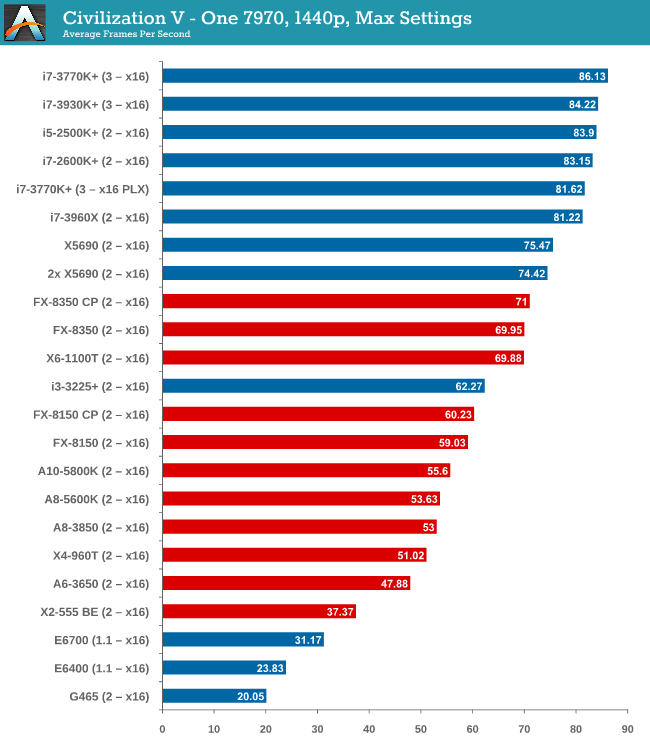
Civilization V is the first game where we see a gap when comparing processor families. A big part of what makes Civ5 perform at the best rates seems to be PCIe 3.0, followed by CPU performance – our PCIe 2.0 Intel processors are a little behind the PCIe 3.0 models. By virtue of not having a PCIe 3.0 AMD motherboard in for testing, the bad rap falls on AMD until PCIe 3.0 becomes part of their main game.
Two 7970s
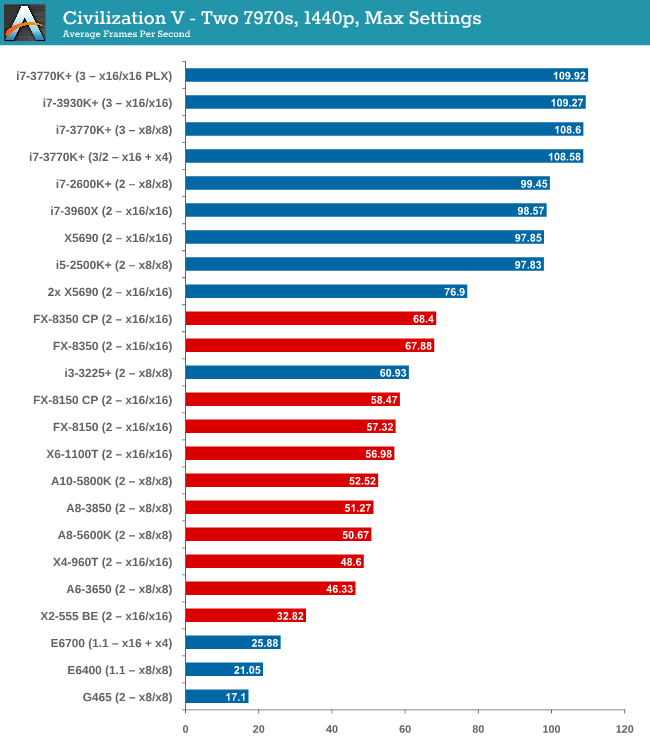
The power of PCIe 3.0 is more apparent with two 7970 GPUs, however it is worth noting that only processors such as the i5-2500K and above have actually improved their performance with the second GPU. Everything else stays relatively similar.
Three 7970s

More cores and PCIe 3.0 are winners here, but no GPU configuration has scaled above two GPUs.
Four 7970s
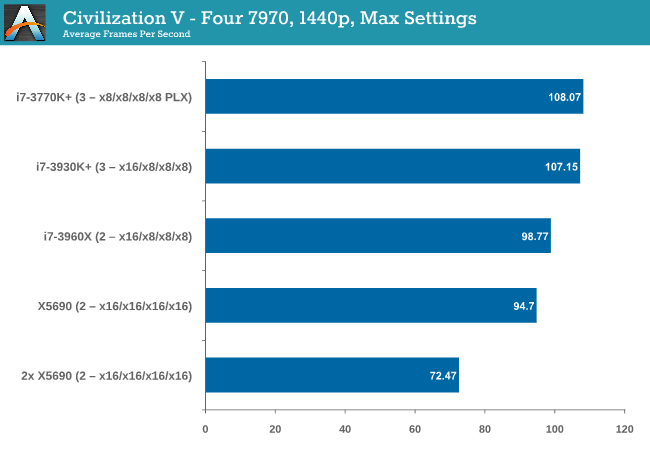
Again, no scaling.
One 580
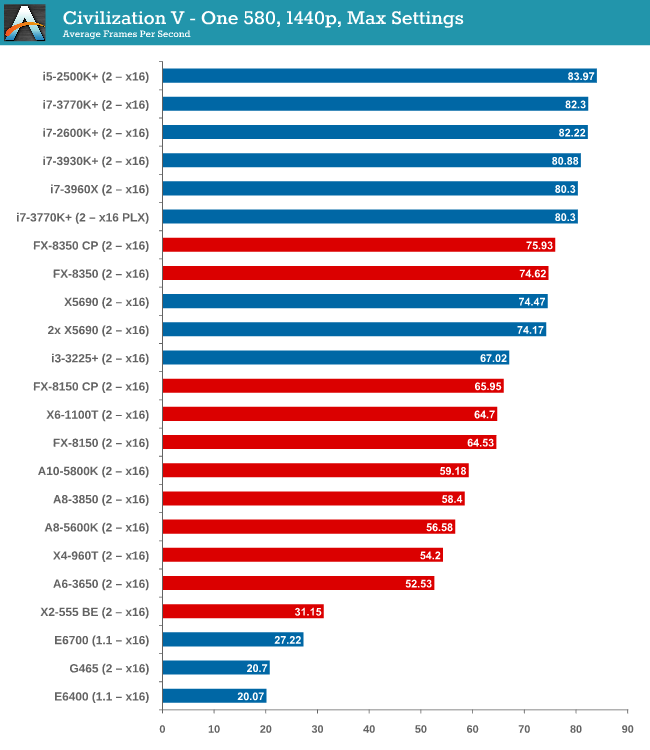
While the top end Intel processors again take the lead, an interesting point is that now we have all PCIe 2.0 values for comparison, the non-hyper threaded 2500K takes the top spot, 10% higher than the FX-8350.
Two 580s
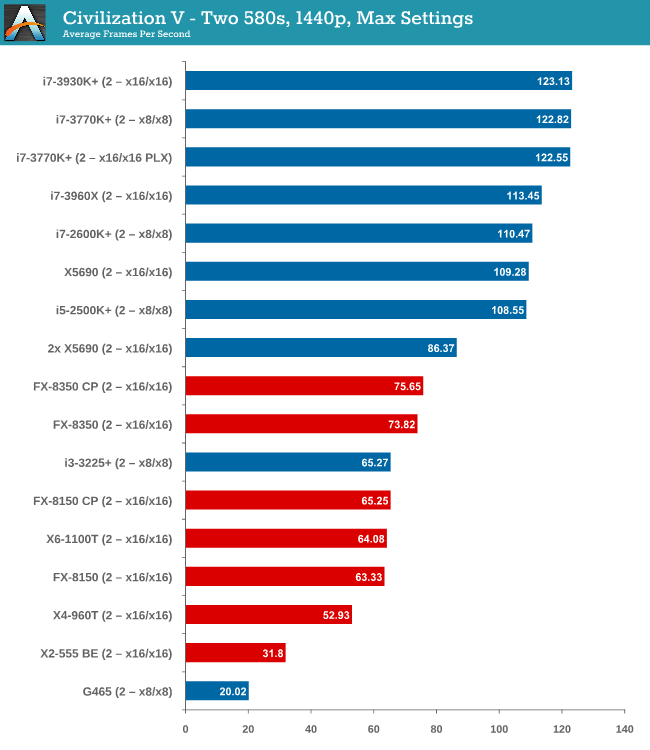
We have another Intel/AMD split, by virtue of the fact that none of the AMD processors scaled above the first GPU. On the Intel side, you need at least an i5-2500K to see scaling, similar to what we saw with the 7970s.
Civilization V conclusion
Intel processors are the clear winner here, though not one stands out over the other. Having PCIe 3.0 seems to be the positive point for Civilization V, but in most cases scaling is still out of the window unless you have a monster machine under your belt.










242 Comments
View All Comments
HalloweenJack - Wednesday, May 8, 2013 - link
nice article - would like to have seen an AMD AM2 setup for comparison though. Sadly though I don't like the obvious intel slant - with comments like ` noticeable gap` between intel and amd cpu`s , yet its under 1 fps! I challenge you to actually see a 1fps difference without a meter...IanCutress - Wednesday, May 8, 2013 - link
I didn't say gap with the small 1 FPS differencess, I said split. Whenever I said gap, there is a sizeable difference ~10%. For the small FPS difference in Dirt 3 + one GTX 580, I said "Similar to the one 7970 setup, using one GTX 580 has a split between AMD and Intel that is quite noticeable. Despite the split, all the CPUs perform within 1.3 FPS, meaning no big difference.". Please don't misinterpret my results when I cater for your issue word for word. If you have an issue with a *specific* analysis, please let me know.HalloweenJack - Wednesday, May 8, 2013 - link
again I disagree - you use the words , chosen carefully - the implication is obvious. `gap` and `split` implying a considerable distance between the 2. when in reality there is none. at least anandtech has finally started using real world resolutions and not the pointless 800x600 . poor choice in ambiguous words In writing.HalloweenJack - Wednesday, May 8, 2013 - link
I must ask though - why does civ and total war do poorly on AMD? and will you be adding an AM2 rig - say a 9850?JarredWalton - Wednesday, May 8, 2013 - link
I disagree; "gap" and "split", particularly taken in context, are very clear in the text. What's more, for someone that appears to be worried about a single word choice, you're at the same time ignoring most of the other words.Gap: A break or hole in an object or between two objects.
Split: A tear, crack, or fissure in something, esp. down the middle or along the grain.
There's a split between AMD and Intel, but in many cases not a gap.
ThomasS31 - Wednesday, May 8, 2013 - link
Yes. A Core2Quad would be nice to see.Also some midrange video cards, like HD7870 and GTX660/Ti.
ThomasS31 - Wednesday, May 8, 2013 - link
My point is, that if you are on a budget, but has a C2Quad system... you may not need a new CPU for a new mid-range videocard.Though I admint these are very close to A8-A10 performance, so if that is enough, a C2Q as well might be good.
BTW a very good article... do you planning doing the same for GPUs? :)
IanCutress - Wednesday, May 8, 2013 - link
I have got a Q9400 coming in from a family member for the next update to this review :) Putting more cards in the review might multiply it out too much time wise :/ If there is more requests to try more mid-range cards, I might move to that and retest everything, if I can get the cards in. The 7970s/580s were the only ones I really have to hand to test multi-GPU.Ian
beepboy - Wednesday, May 8, 2013 - link
You're right about the cards, a waste of time - unless its more budget oriented.Pjotr - Wednesday, May 15, 2013 - link
Core2Quad, like my Q9450-ish, I'd only like to know if buying a modern 660 or similar will not hamper that card too much. Not very interested in multi-card configs. Great review you did, but I only looked at the single-card table. I think most people try to balance the single CPU vs GPU upgrade cycles.